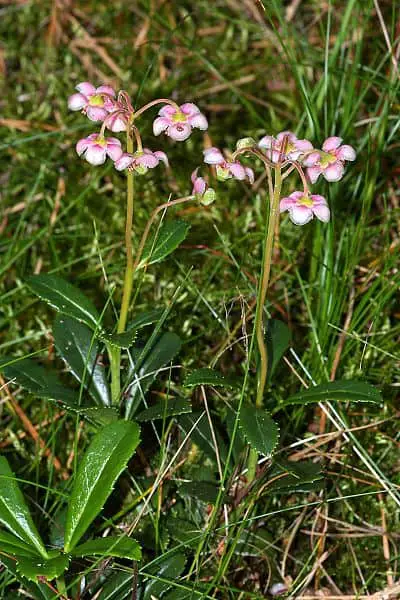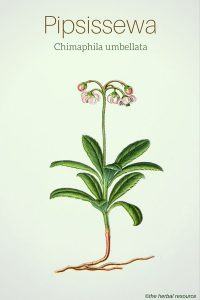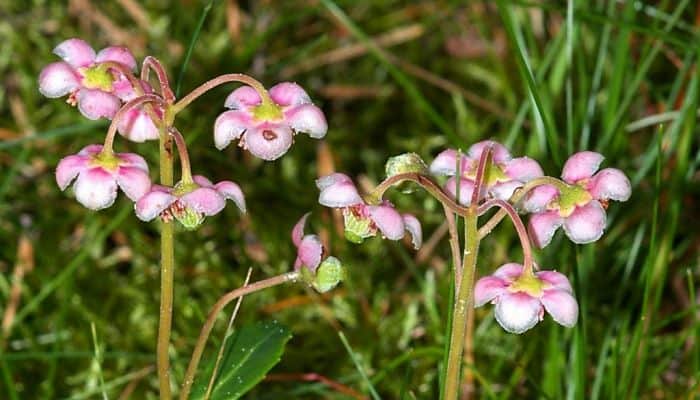Botanical Name of Pipsissewa: Chimaphila umbellata.
The name pipsissewa comes from the Cree Indians. The name means “broken into small pieces” and is derived from the notion that the herb could dissolve kidney stones.
Other Common Names: Ground holly, prince’s pine, king’s cure, bitter wintergreen, false wintergreen, umbellate wintergreen, rheumatism weed, skærm-vintergrøn (Danish), pyrole en ombrelle (French), Winterlieb (German), chimaphila (Spanish).
Habitat: Pipsissewa has a circumboreal distribution and is found in the boreal forest or taiga in the northern parts of Europe, Asia, and North America.
Description: Chimaphila umbellata is 10-25 cm tall dwarf shrub with creeping and woody rootstock.
The stiff, leathery, narrow oval evergreen leaves are 3-7 cm long with coarsely serrated edges.
Each flower stem has 3-10 white or pink, cup-shaped flowers that are gathered in a display. The flowers are 7-12 mm in diameter and sit on 1-2 cm long, curved flower shafts.
The flowering begins in late summer and continues into autumn. The seed capsules are erect and contain many very small seeds.
Plant Parts Used: The aerial part or only the leaves are gathered when the plant is in flower and dried for later use in herbal teas and liquid extracts.
The fresh leaves can be used externally as a poultice.

Therapeutic Uses, Benefits and Claims of Pipsissewa
Pipsissewa contains quinones (hydroquinones), flavonoids, triterpenes, phenols, methyl salicylate, essential oil, and tannins. Quinones have been proven to have a disinfecting effect on the urinary tract.
Pipsissewa was an important herb among the native Americans in North America, and they used it in the form of herbal teas for a variety of health problems, especially as a tonic and diuretic medication for rheumatism, kidney and bladder ailments. The herb was also popular among the European settlers.
Modern scientific studies have confirmed that the plant can be useful as a diuretic and urinary tract disinfectant.
It was widely used and highly regarded by herbal practitioners in North America as a safe and reliable antiseptic and antibacterial agent for treatment of cystitis, painful urination, bladder and kidney stones, kidney inflammation, prostatitis, gonorrhea and other ailments.
The herb helps the body to get rid of excess fluid and waste products by increasing urinary flow and improve liver function.
Drinking tea made from pipsissewa may be effective as a remedy for rheumatism, arthritis and gout.
Animal studies have shown that extracts of the herb also have the ability to lower high blood glucose values.
Chimaphila umbellata has the same effect on the urinary system as bearberry (Arctostaphylos uva-ursi). Both these plants have hydroquinone as the main active ingredient.
Pipsissewa has a lower content of tannins than bearberry and more diuretic properties which make it more suitable for long-term use.
North American Indians used the plant to increase sweating, to treat fever diseases (like typhoid) and as a fevers reduce agent.
They also used it for painful menstruation and tuberculosis of the lymph glands of the neck.
Pipsissewa is a bitter herb which has been used internally as a tea to treat ailments of the respiratory tract like colds, whooping cough and bronchitis.
Furthermore, it was used as a remedy for lack of appetite and poor digestion.
Externally, an extract of pipsissewa was used as an astringent eyewash for sore eyes. Extracts of the fresh leaves can be used as a wash or wet compresses on the blisters, tumors, ulcers, and swelling.
Fresh plant material can be placed directly on the skin as a painkiller for rheumatism in the joints and muscles.
The leaves have has also been used as a tobacco substitute.
Dosage and Administration
Herbal tea can be made by steeping 1 teaspoon of the dried crushed leaves in a cup of boiling water, wait until it becomes cold and then strain. 1-2 cups a day of the cold tea can be taken daily.
Extracts of the same strength can also be used externally as a poultice for boils and infected wounds.
In addition, commercial pipsissewa tincture can be used, where the manufacture’s instruction should be followed.
Potential Side Effects and Interactions of Pipsissewa
The substance hydroquinone found in pipsissewa is toxic in large doses and prolonged use of the herb can be harmful. Large doses can cause diarrhea, nausea, and vomiting.
Pipsissewa can give urine a green color, but it is not dangerous.
Due to the content of tannins, it can reduce the absorption of some medication in the intestine and therefore the herb should be taken a few hours before or after any medication.
People with iron deficiency and generally poor nutrient absorption should avoid this herb.
The effect of this herb on women how are pregnant and breastfeeding is not known so a trained herbalist or other professional healthcare providers should be contacted before using pipsissewa as a medicinal herb.
The plant can cause contact allergy and rash in some people.
Other Resources on Pipsissewa
Herb(s) of the Week: Pipsissewa
Supporting References
Wood, Matthew: The Earthwise Herbal. A Complete Guide to New World Medicinal Plants. Berkeley, California, North Atlantic Books 2009
Williamson, Elisabeth M.: Potter’s Herbal Cyclopedia. Essex, Saffron Walden 2003.
Tilford, Gregory L.: Edible and Medicinal Plants of the West. Missoula, Montana, Mountain Press Publishing Company 1997.
Skenderi, Gazmend: Herbal Vade Mecum. 800 Herbs, Spices, Essential Oils, Lipids Etc. Constituents, Properties, Uses, and Caution. Rutherford, New Jersey, Herbacy Press 2003.
Mars, Brigitte: The Desktop Guide to Herbal Medicine. Laguna Beach. Basic Health Publications, Inc. 2007.
Lucas, Richard M.: Miracle Medicine Herbs. Englewood Cliffs, New Jersey, Prentice Hall 1991.
Karalliedde, Lakshman & Indika Gawarammane: Traditional Herbal Medicines, a guide to their safer use.London, Hammersmith Press Ltd. 2008.
Hensel, Wolfgang: Medicinal Plants of Britain and Europe. London, A&C Black Publishers Ltd. 2008.
Foster, Stewen and James A. Duke: A Field Guide to Medicinal Plants, Eastern and Central North America. New York, Houghton Mifflin Company 1990.
Thordur Sturluson
Latest posts by Thordur Sturluson (see all)
- What is the Difference Between Hemp and Marijuana? - June 3, 2019


Cam a tincture be made from princes pine and if so, how to use it internally. I have always used this herb for urinary tract problems as tea.
T andrew
I think the literature explained in detail what it can and should not be used for. It also gave a list of reference material. It was a very informative write. And also covered the basic uses and possible side affects in enough detail for a responsible amature to make a sound decision. Good job.